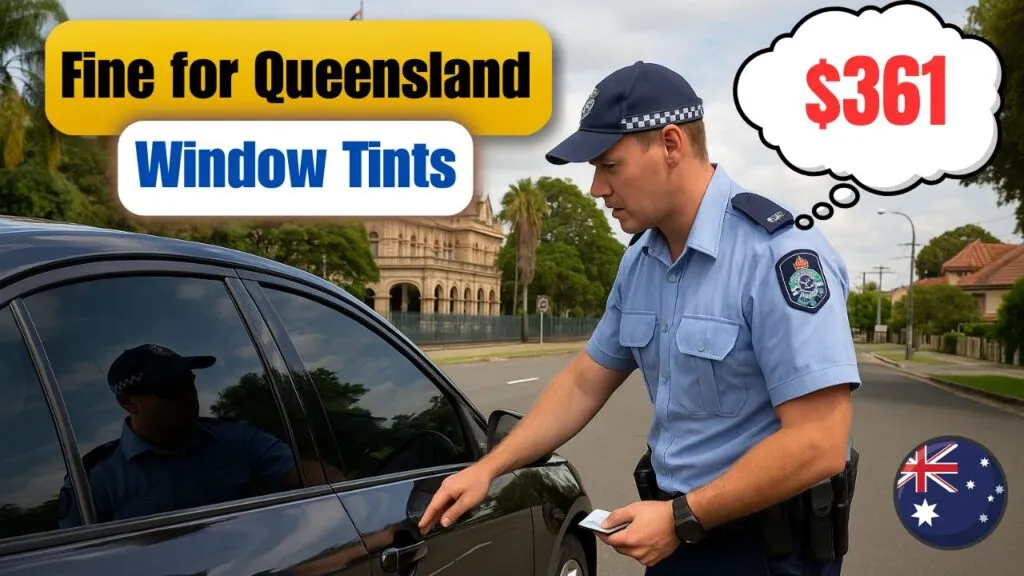Queensland is tightening enforcement on illegal dark window tints from October 2025, with on‑the‑spot fines of $361 for vehicles that exceed legal Visible Light Transmission (VLT) limits across front and rear glazing to improve road safety and visibility. The rules target excessively dark and reflective films, mandate specific VLT thresholds, and empower police to measure compliance at the roadside using approved light meters.
Legal limits at a glance
- Front side windows must allow at least 35% of light through (minimum 35% VLT).
- Rear side and back windows may be as low as 20% VLT where permitted.
- Windscreens may only have an upper visor strip (generally top 10%) with no additional darkening in the driver’s field of view.
- Reflective or mirror-effect tints are prohibited on all vehicles.
- Police can issue $361 fines and defect notices; repeat breaches may trigger inspections, removal orders, or registration impacts.
These limits exist to keep forward and lateral visibility adequate in day, night, and adverse weather, and to ensure officers can safely assess occupants and hazards during traffic stops.
Why enforcement is increasing
Authorities are prioritising consistent visibility standards because overly dark tints can reduce a driver’s ability to detect pedestrians, cyclists, and road signs, particularly after dusk or in rain. Excess tint also impairs inter‑vehicle communication (eye contact and hand signals) and can complicate crash avoidance. For enforcement, officers need a clear view into cabins for safety and compliance checks; mirror and heavy films defeat that purpose. The $361 penalty is intended to deter risky modifications while aligning vehicle fleets with uniform safety benchmarks.
What changes from October 2025
The key shift isn’t the headline VLT thresholds—those remain familiar to most motorists—but the intensity and immediacy of enforcement. Police and Transport and Main Roads (TMR) officers are slated to expand roadside VLT testing, issue more immediate fines for non‑compliance, and follow with defect or inspection notices where vehicles present broader safety concerns. Tint installers are also expected to verify compliance more rigorously, with documentation recommended for motorists.
How to check compliance before a fine
- Use accredited installers that test VLT with calibrated meters and provide written VLT results per window.
- Ask for a compliance statement referencing each pane’s VLT and applicable legal threshold.
- Keep receipts and the compliance document in the glovebox for roadside queries.
- Re‑test after any glass replacement or when layering film over factory privacy glass, which can push VLT below legal minima.
- Avoid reflective or mirror films altogether; aesthetics don’t outweigh prohibition.
- If purchasing a used vehicle, request VLT results as part of pre‑purchase checks.
Detailed limits, penalties, and oversight
- Front side windows: Minimum 35% VLT; non‑compliance can attract a $361 fine and, where appropriate, a defect notice requiring rectification by a set date.
- Rear side and rear window: Minimum 20% VLT where allowed; non‑compliance can attract the same $361 fine and follow‑up inspection requirements.
- Windscreen: Only the upper visor strip (approximately the top 10%) may be tinted; any additional darkening in the driver’s sweep area risks a $361 fine plus inspection notice.
- Reflective/mirror tint: Not permitted; expect a $361 fine and an order to remove the film promptly.
- Repeat offences: Vehicles may be declared unroadworthy until corrected, with higher penalties possible alongside registration or use restrictions for persistent non‑compliance.
- Enforcement bodies: Queensland Police Service conducts roadside checks and issues fines; TMR oversees standards, inspections, and defect clearance.
Practical tips to stay legal in 2025
- Choose films clearly labeled with VLT values matching Queensland thresholds for each window position.
- Avoid stacking aftermarket film over factory privacy glass, which often starts around 20–25% VLT at the rear and leaves no margin for additional darkening.
- Verify that installer test readings are taken on the glass after installation, not just from film packaging specifications.
- Maintain good night‑driving visibility: darker is not safer. A compliant 35% front VLT balances glare reduction with hazard detection.
- If stopped, be courteous and provide installation documents; motorists who show good‑faith compliance often move directly to defect rectification rather than escalating penalties.
Safety benefits that underpin the rules
Legal VLT limits are calibrated to preserve contrast sensitivity and depth perception under low‑light conditions, both crucial to spotting pedestrians at crossings and reading wet‑road cues. They also help other drivers and vulnerable road users anticipate a vehicle’s movements by maintaining mutual visibility. For policing, clear visibility reduces risk in roadside interactions, enabling faster, safer assessments without unnecessary escalation.
Frequently asked questions
- Can medical exemptions permit darker tints? Limited exemptions may exist for specific, documented medical conditions, but they are exceptional and must be formally approved; most drivers should plan within the standard thresholds.
- Is “privacy glass” the same as tint? Factory privacy glass is dyed glass rather than applied film, but its effect on VLT counts toward the legal limit; adding film on top can quickly drop below compliance.
- Do SUVs and utes have different rules? Rear-area allowances can vary by body style, but front side window and windscreen limits remain strict and consistent for all light vehicles; confirm specifics at the time of installation.
Bottom line
From October 2025, Queensland will actively issue $361 fines for illegal window tints while escalating defect and inspection actions for repeat breaches. Staying compliant is straightforward: keep front windows at 35% VLT or lighter, rear areas at or above 20% VLT where permitted, use only a visor strip on the windscreen, and avoid all reflective films. Test, document, and re‑check after glass work to ensure the vehicle remains within legal—and safe—limits.
